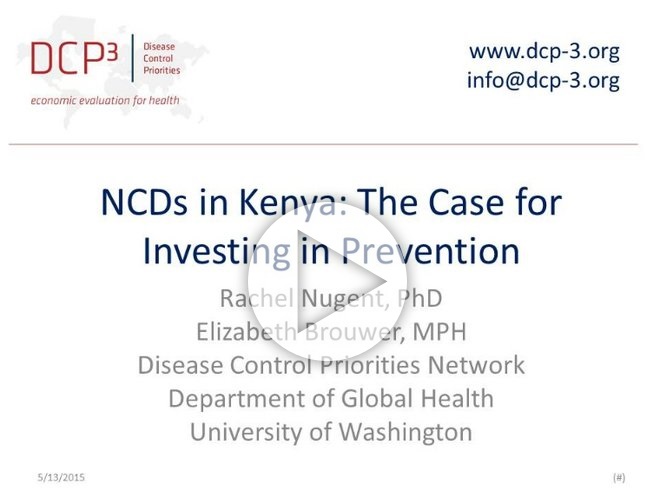Kenya Perspective: Non-Communicable Diseases
Background
Non-communicable diseases (NCDs) – ‘lifestyle’ diseases such as diabetes, cancer and stroke – are a major global problem, and the post-2015 development agenda will most likely include a target to reduce premature death from NCDs by one third by 2030. Although often thought of as conditions suffered in the developed world, in fact about half of all deaths in low- and middle-income countries are due to NCDs, with about 30% being premature (below age 60).
Kenya has a young but aging population. Currently the proportion of the population aged over 50 is 17% and by 2050 the number of adults is expected to almost triple, from 21 million to about 60 million. A growing number of premature deaths are due to NCDs, with half of all hospital admissions and deaths being NCD related at present. Roughly a quarter of all deaths are caused by NCDs, with cancer and cardiovascular disease (including heart attacks and strokes) being the biggest killers.
Apart from the human problems, there are real economic consequences: NCDs are often chronic, trapping households in a cycle of poor health and debt and increasing social and economic inequality. Kenya and regional neighbours have ratified the WHO Framework Convention on Tobacco Control and civil society organisations are partnering with universities and global institutions to raise awareness of NCDs more generally and take action against them. But more must be done and there are policies which can address the two most important risk factors for NCDs, tobacco use and hypertension.
Long experience in high-income countries has demonstrated a clear link between smoking and health. This also shows that introducing relatively high rates of taxation is a cost-effective way to reduce both tobacco consumption and its negative effects on health.
Kenya currently has a relatively low prevalence of smoking, which puts it in a good position to stem the epidemic and particularly influence the younger generation of would-be smokers away from starting. Currently, by far the greatest consumption of tobacco is from adult males smoking cigarettes, with estimates of about one in five Kenyan men being smokers. The Tobacco Control Act already prohibits smoking in public or in places of work, but it is poorly enforced, and between 18 and 30% of adults are exposed to smoke in public places or at work.
Although taxes are levied on cigarettes in Kenya, the current price of a pack is 103 shillings. We propose a 150% increase in the real price of tobacco products, bringing the price of a packet of cigarettes to around 250 shillings. We expect this to reduce demand by 60% by 2030. Assuming 7,600 deaths from smoking in 2030, a 60% cut in this would save up to 4,600 lives. Each death averted would lead on average to 15 extra years of productive life. Assuming a year of life is worth between $1,000 and $5,000, this tax increase would on average produce benefits of over 14 shillings for each one spent.
A second serious health risk is hypertension (high blood pressure) which is the most common cardiovascular problem in sub-Saharan Africa. Untreated, this can lead to heart disease, stroke or diabetes, any one of which could be fatal. Obesity, stress, reduced physical activity, poor diet and smoking are all contributing to higher rates of hypertension in Kenya, although this is still lower than for other sub-Saharan African countries.
Relatively cheap drugs are in principle available to manage blood pressure successfully if taken regularly. However, these are not always readily available or affordable to the people who need them. Assuming the current death rate from high blood pressure remains the same, there would be about 27,000 deaths from the condition in 2030. Assuming about half the people in need could be reached and about 30% of them continued to take the medicine, at least 4,000 lives could be saved.
At a cost of $2.50 per head, treating 1.4 million people would cost just $3.5 million in 2030. The benefits would greatly outweigh this, and every shilling spent on treating hypertension would pay back 37 shillings in benefits.


